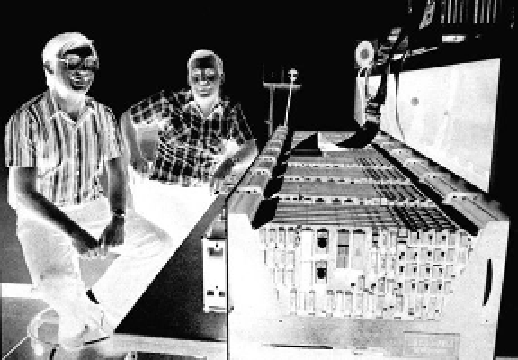Information Technology Reference
In-Depth Information
Such simulations have now become an essential
element of car design with detailed crash simula-
tion using models of the driver and passengers.
By the 1980s microprocessors based on new
transistor technology (CMOS) started to appear as
alternative building blocks of supercomputers.
Cray was rather skeptical and when he was asked
whether he had considered building the next
generation of Cray computers on the new com-
ponents he famously said “If you have a heavy
load to move. What would you rather use a pair of
oxen or hundred of chicken.”
19
However, in the early 1980s, Geoffrey Fox
and Chuck Seitz at Caltech put together a paral-
lel computer called the Cosmic Cube. In essence,
this was a collection of IBM PC boards, each
with an Intel microprocessor and memory, con-
nected together by a so-called
hypercube network
.
The importance of the Cosmic Cube experience
was that Fox and Seitz demonstrated for the first
time that it was both feasible and realistic to use
such “distributed memory” parallel computers to
solve challenging scientific problems. In this case,
programmers need to exploit domain parallelism
as shown in
Figure 7.20b
. Instead of the latency
caused by filling and emptying a vector pipeline,
the overhead in such distributed memory programs comes from the need to exchange information at the
boundaries of the domains since the data is subdivided among the different nodes of the machine. This style
of parallel programming is called
message passing
.
Today, all the highest performance computers use such a distributed memory, message passing archi-
tecture, albeit with a variety of different types of networks connecting the processing nodes. Instead of
the Cray-1's eighty Mflop/s peak performance, we now have distributed memory supercomputers with top
speeds of teraflop/s and petaflop/s, while gigaflop/s performance is now routinely available on a laptop! The
supercomputing frontier is to break the exaflop/s barrier and there are now U.S., Japanese, European, and
Chinese companies taking on this challenge. In answer to Cray's sarcastic comment about hundreds of
chickens, Eugene Brooks III, one of the original Cosmic Cube team at Caltech, characterized the success of
commodity-chip based, distributed memory machines as “the attack of the killer micros.”
20
Fig. 7.24. Geoffrey Fox and Chuck Seitz pictured next to the Caltech
Cosmic Cube machine. This parallel computer became operational
in October 1983 and contained sixty-four nodes each with 128
kilobyte memory. A computing node was made up from an Intel
8086 processor with an 8087 coprocessor for fast floating-point
operations. The nodes were linked together in a so-called hyper-
cube topology - several cubes connected together - for minimizing
communication delays between nodes. The size of the computer
was only six cubic feet and drew less than a kilowatt of power. The
Cosmic Cube and its successors represented a serious challenge for
the Cray vector supercomputers. Today all the highest-performing
machines use a distributed memory message-passing architecture
similar to the Caltech design.


Search WWH ::

Custom Search